Business Transformation through Enterprise System
VerifiedAdded on 2023/03/30
|6
|1167
|233
AI Summary
This report explains the transformation of business environments through the adoption of various technologies. It discusses the significance of enterprise systems and reviews articles on cloud integration, product service solutions, and enterprise models. The report highlights the benefits of cloud integration for cost reduction and performance improvement, and emphasizes the role of IT systems and software requirements in business transformation.
Contribute Materials
Your contribution can guide someone’s learning journey. Share your
documents today.
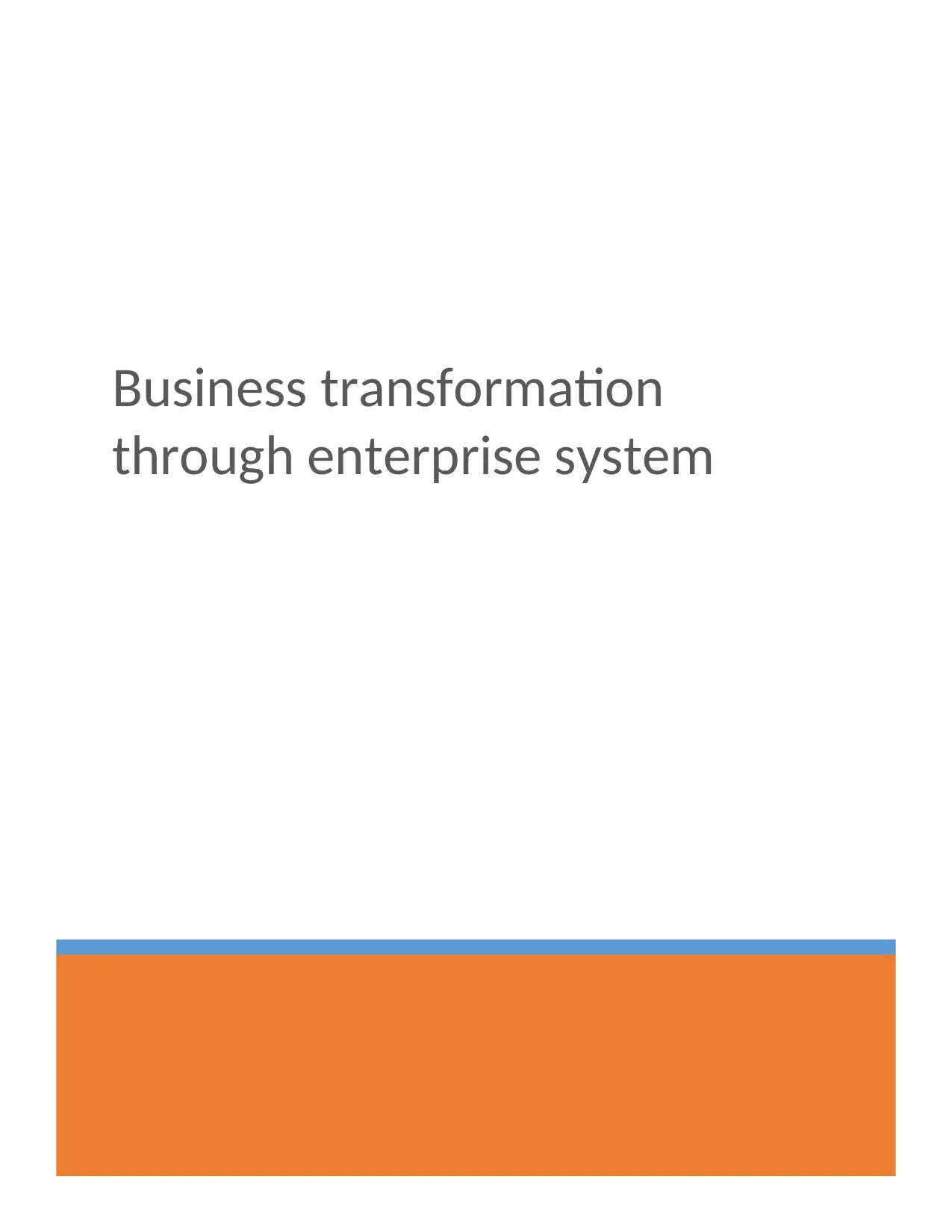
Business transformation
through enterprise system
through enterprise system
Secure Best Marks with AI Grader
Need help grading? Try our AI Grader for instant feedback on your assignments.
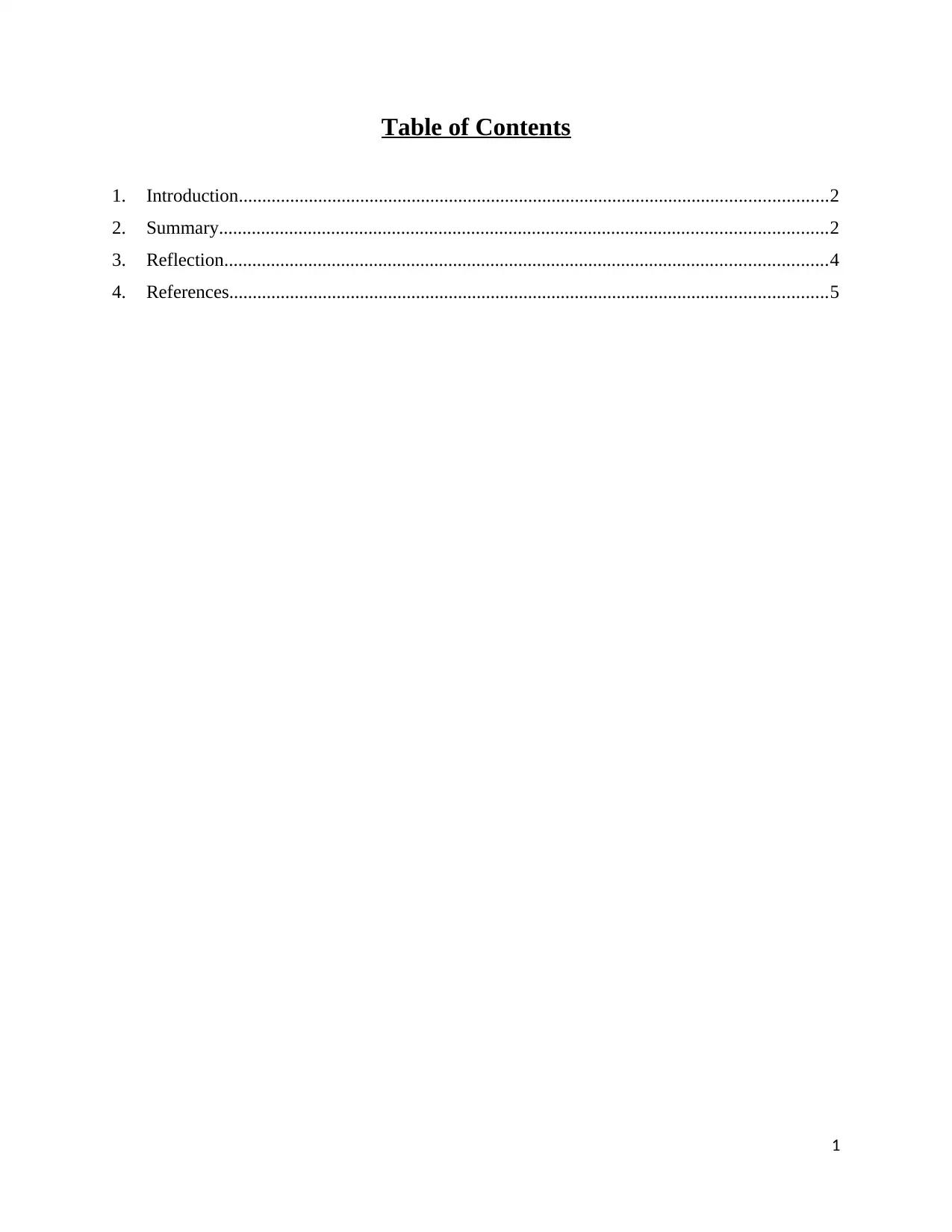
Table of Contents
1. Introduction..............................................................................................................................2
2. Summary..................................................................................................................................2
3. Reflection.................................................................................................................................4
4. References................................................................................................................................5
1
1. Introduction..............................................................................................................................2
2. Summary..................................................................................................................................2
3. Reflection.................................................................................................................................4
4. References................................................................................................................................5
1
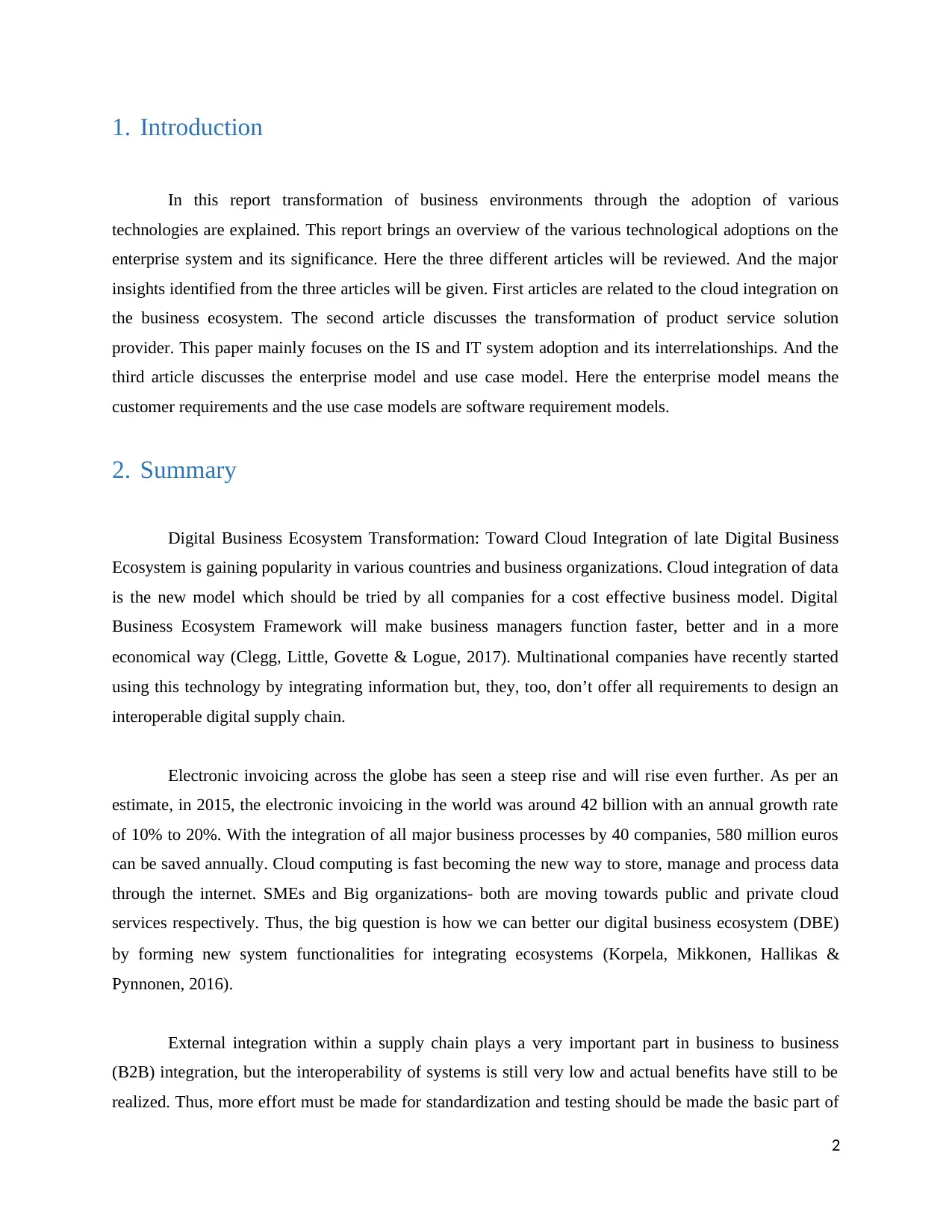
1. Introduction
In this report transformation of business environments through the adoption of various
technologies are explained. This report brings an overview of the various technological adoptions on the
enterprise system and its significance. Here the three different articles will be reviewed. And the major
insights identified from the three articles will be given. First articles are related to the cloud integration on
the business ecosystem. The second article discusses the transformation of product service solution
provider. This paper mainly focuses on the IS and IT system adoption and its interrelationships. And the
third article discusses the enterprise model and use case model. Here the enterprise model means the
customer requirements and the use case models are software requirement models.
2. Summary
Digital Business Ecosystem Transformation: Toward Cloud Integration of late Digital Business
Ecosystem is gaining popularity in various countries and business organizations. Cloud integration of data
is the new model which should be tried by all companies for a cost effective business model. Digital
Business Ecosystem Framework will make business managers function faster, better and in a more
economical way (Clegg, Little, Govette & Logue, 2017). Multinational companies have recently started
using this technology by integrating information but, they, too, don’t offer all requirements to design an
interoperable digital supply chain.
Electronic invoicing across the globe has seen a steep rise and will rise even further. As per an
estimate, in 2015, the electronic invoicing in the world was around 42 billion with an annual growth rate
of 10% to 20%. With the integration of all major business processes by 40 companies, 580 million euros
can be saved annually. Cloud computing is fast becoming the new way to store, manage and process data
through the internet. SMEs and Big organizations- both are moving towards public and private cloud
services respectively. Thus, the big question is how we can better our digital business ecosystem (DBE)
by forming new system functionalities for integrating ecosystems (Korpela, Mikkonen, Hallikas &
Pynnonen, 2016).
External integration within a supply chain plays a very important part in business to business
(B2B) integration, but the interoperability of systems is still very low and actual benefits have still to be
realized. Thus, more effort must be made for standardization and testing should be made the basic part of
2
In this report transformation of business environments through the adoption of various
technologies are explained. This report brings an overview of the various technological adoptions on the
enterprise system and its significance. Here the three different articles will be reviewed. And the major
insights identified from the three articles will be given. First articles are related to the cloud integration on
the business ecosystem. The second article discusses the transformation of product service solution
provider. This paper mainly focuses on the IS and IT system adoption and its interrelationships. And the
third article discusses the enterprise model and use case model. Here the enterprise model means the
customer requirements and the use case models are software requirement models.
2. Summary
Digital Business Ecosystem Transformation: Toward Cloud Integration of late Digital Business
Ecosystem is gaining popularity in various countries and business organizations. Cloud integration of data
is the new model which should be tried by all companies for a cost effective business model. Digital
Business Ecosystem Framework will make business managers function faster, better and in a more
economical way (Clegg, Little, Govette & Logue, 2017). Multinational companies have recently started
using this technology by integrating information but, they, too, don’t offer all requirements to design an
interoperable digital supply chain.
Electronic invoicing across the globe has seen a steep rise and will rise even further. As per an
estimate, in 2015, the electronic invoicing in the world was around 42 billion with an annual growth rate
of 10% to 20%. With the integration of all major business processes by 40 companies, 580 million euros
can be saved annually. Cloud computing is fast becoming the new way to store, manage and process data
through the internet. SMEs and Big organizations- both are moving towards public and private cloud
services respectively. Thus, the big question is how we can better our digital business ecosystem (DBE)
by forming new system functionalities for integrating ecosystems (Korpela, Mikkonen, Hallikas &
Pynnonen, 2016).
External integration within a supply chain plays a very important part in business to business
(B2B) integration, but the interoperability of systems is still very low and actual benefits have still to be
realized. Thus, more effort must be made for standardization and testing should be made the basic part of
2
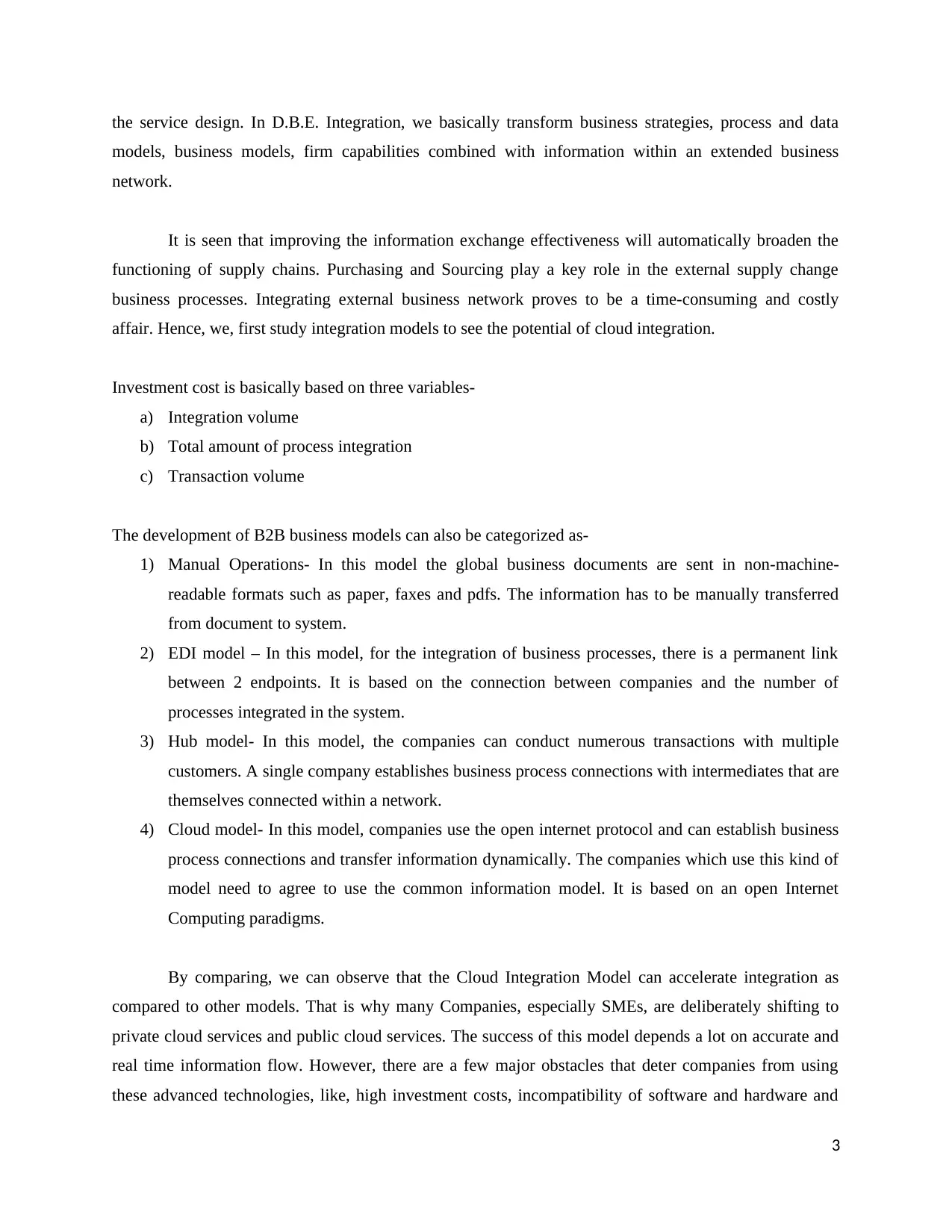
the service design. In D.B.E. Integration, we basically transform business strategies, process and data
models, business models, firm capabilities combined with information within an extended business
network.
It is seen that improving the information exchange effectiveness will automatically broaden the
functioning of supply chains. Purchasing and Sourcing play a key role in the external supply change
business processes. Integrating external business network proves to be a time-consuming and costly
affair. Hence, we, first study integration models to see the potential of cloud integration.
Investment cost is basically based on three variables-
a) Integration volume
b) Total amount of process integration
c) Transaction volume
The development of B2B business models can also be categorized as-
1) Manual Operations- In this model the global business documents are sent in non-machine-
readable formats such as paper, faxes and pdfs. The information has to be manually transferred
from document to system.
2) EDI model – In this model, for the integration of business processes, there is a permanent link
between 2 endpoints. It is based on the connection between companies and the number of
processes integrated in the system.
3) Hub model- In this model, the companies can conduct numerous transactions with multiple
customers. A single company establishes business process connections with intermediates that are
themselves connected within a network.
4) Cloud model- In this model, companies use the open internet protocol and can establish business
process connections and transfer information dynamically. The companies which use this kind of
model need to agree to use the common information model. It is based on an open Internet
Computing paradigms.
By comparing, we can observe that the Cloud Integration Model can accelerate integration as
compared to other models. That is why many Companies, especially SMEs, are deliberately shifting to
private cloud services and public cloud services. The success of this model depends a lot on accurate and
real time information flow. However, there are a few major obstacles that deter companies from using
these advanced technologies, like, high investment costs, incompatibility of software and hardware and
3
models, business models, firm capabilities combined with information within an extended business
network.
It is seen that improving the information exchange effectiveness will automatically broaden the
functioning of supply chains. Purchasing and Sourcing play a key role in the external supply change
business processes. Integrating external business network proves to be a time-consuming and costly
affair. Hence, we, first study integration models to see the potential of cloud integration.
Investment cost is basically based on three variables-
a) Integration volume
b) Total amount of process integration
c) Transaction volume
The development of B2B business models can also be categorized as-
1) Manual Operations- In this model the global business documents are sent in non-machine-
readable formats such as paper, faxes and pdfs. The information has to be manually transferred
from document to system.
2) EDI model – In this model, for the integration of business processes, there is a permanent link
between 2 endpoints. It is based on the connection between companies and the number of
processes integrated in the system.
3) Hub model- In this model, the companies can conduct numerous transactions with multiple
customers. A single company establishes business process connections with intermediates that are
themselves connected within a network.
4) Cloud model- In this model, companies use the open internet protocol and can establish business
process connections and transfer information dynamically. The companies which use this kind of
model need to agree to use the common information model. It is based on an open Internet
Computing paradigms.
By comparing, we can observe that the Cloud Integration Model can accelerate integration as
compared to other models. That is why many Companies, especially SMEs, are deliberately shifting to
private cloud services and public cloud services. The success of this model depends a lot on accurate and
real time information flow. However, there are a few major obstacles that deter companies from using
these advanced technologies, like, high investment costs, incompatibility of software and hardware and
3
Secure Best Marks with AI Grader
Need help grading? Try our AI Grader for instant feedback on your assignments.
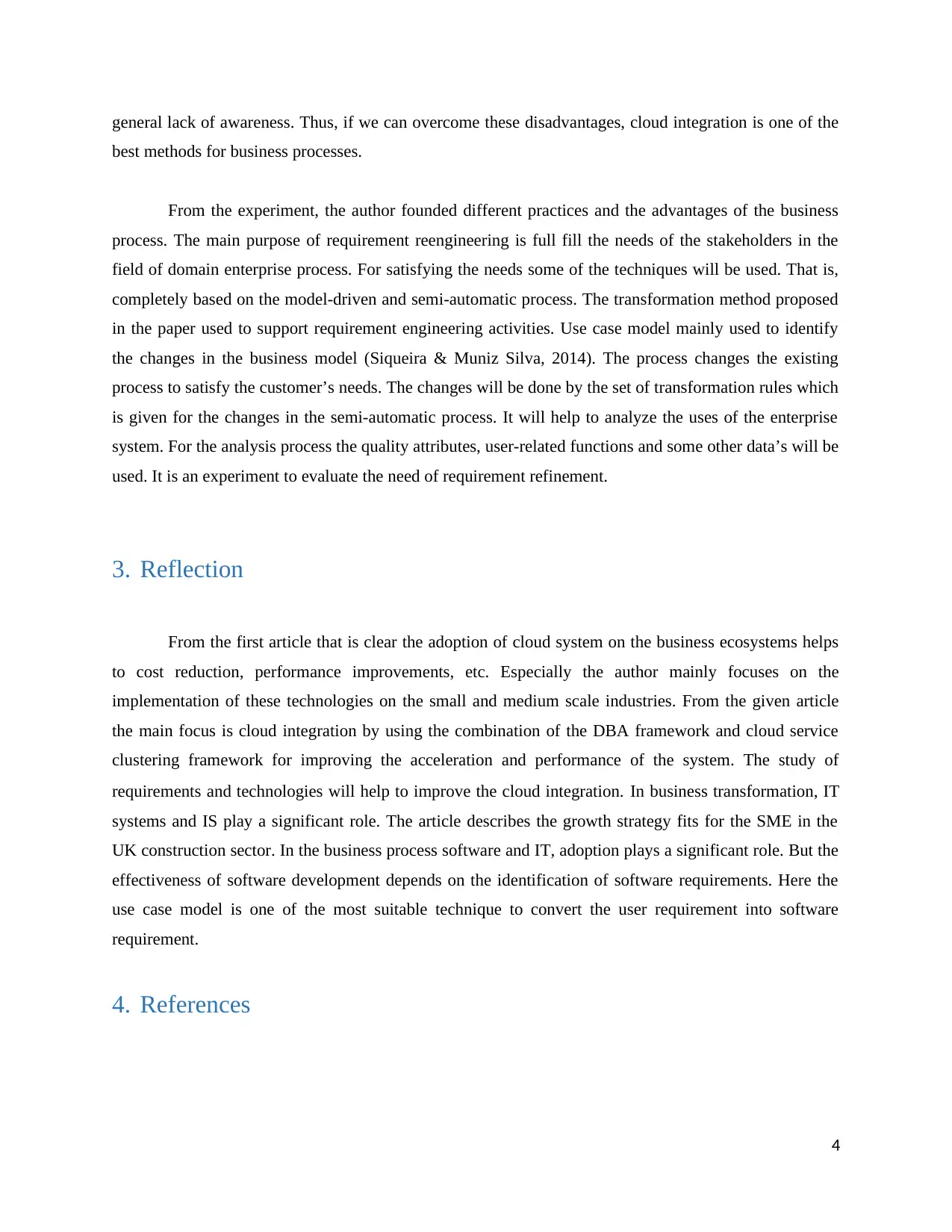
general lack of awareness. Thus, if we can overcome these disadvantages, cloud integration is one of the
best methods for business processes.
From the experiment, the author founded different practices and the advantages of the business
process. The main purpose of requirement reengineering is full fill the needs of the stakeholders in the
field of domain enterprise process. For satisfying the needs some of the techniques will be used. That is,
completely based on the model-driven and semi-automatic process. The transformation method proposed
in the paper used to support requirement engineering activities. Use case model mainly used to identify
the changes in the business model (Siqueira & Muniz Silva, 2014). The process changes the existing
process to satisfy the customer’s needs. The changes will be done by the set of transformation rules which
is given for the changes in the semi-automatic process. It will help to analyze the uses of the enterprise
system. For the analysis process the quality attributes, user-related functions and some other data’s will be
used. It is an experiment to evaluate the need of requirement refinement.
3. Reflection
From the first article that is clear the adoption of cloud system on the business ecosystems helps
to cost reduction, performance improvements, etc. Especially the author mainly focuses on the
implementation of these technologies on the small and medium scale industries. From the given article
the main focus is cloud integration by using the combination of the DBA framework and cloud service
clustering framework for improving the acceleration and performance of the system. The study of
requirements and technologies will help to improve the cloud integration. In business transformation, IT
systems and IS play a significant role. The article describes the growth strategy fits for the SME in the
UK construction sector. In the business process software and IT, adoption plays a significant role. But the
effectiveness of software development depends on the identification of software requirements. Here the
use case model is one of the most suitable technique to convert the user requirement into software
requirement.
4. References
4
best methods for business processes.
From the experiment, the author founded different practices and the advantages of the business
process. The main purpose of requirement reengineering is full fill the needs of the stakeholders in the
field of domain enterprise process. For satisfying the needs some of the techniques will be used. That is,
completely based on the model-driven and semi-automatic process. The transformation method proposed
in the paper used to support requirement engineering activities. Use case model mainly used to identify
the changes in the business model (Siqueira & Muniz Silva, 2014). The process changes the existing
process to satisfy the customer’s needs. The changes will be done by the set of transformation rules which
is given for the changes in the semi-automatic process. It will help to analyze the uses of the enterprise
system. For the analysis process the quality attributes, user-related functions and some other data’s will be
used. It is an experiment to evaluate the need of requirement refinement.
3. Reflection
From the first article that is clear the adoption of cloud system on the business ecosystems helps
to cost reduction, performance improvements, etc. Especially the author mainly focuses on the
implementation of these technologies on the small and medium scale industries. From the given article
the main focus is cloud integration by using the combination of the DBA framework and cloud service
clustering framework for improving the acceleration and performance of the system. The study of
requirements and technologies will help to improve the cloud integration. In business transformation, IT
systems and IS play a significant role. The article describes the growth strategy fits for the SME in the
UK construction sector. In the business process software and IT, adoption plays a significant role. But the
effectiveness of software development depends on the identification of software requirements. Here the
use case model is one of the most suitable technique to convert the user requirement into software
requirement.
4. References
4
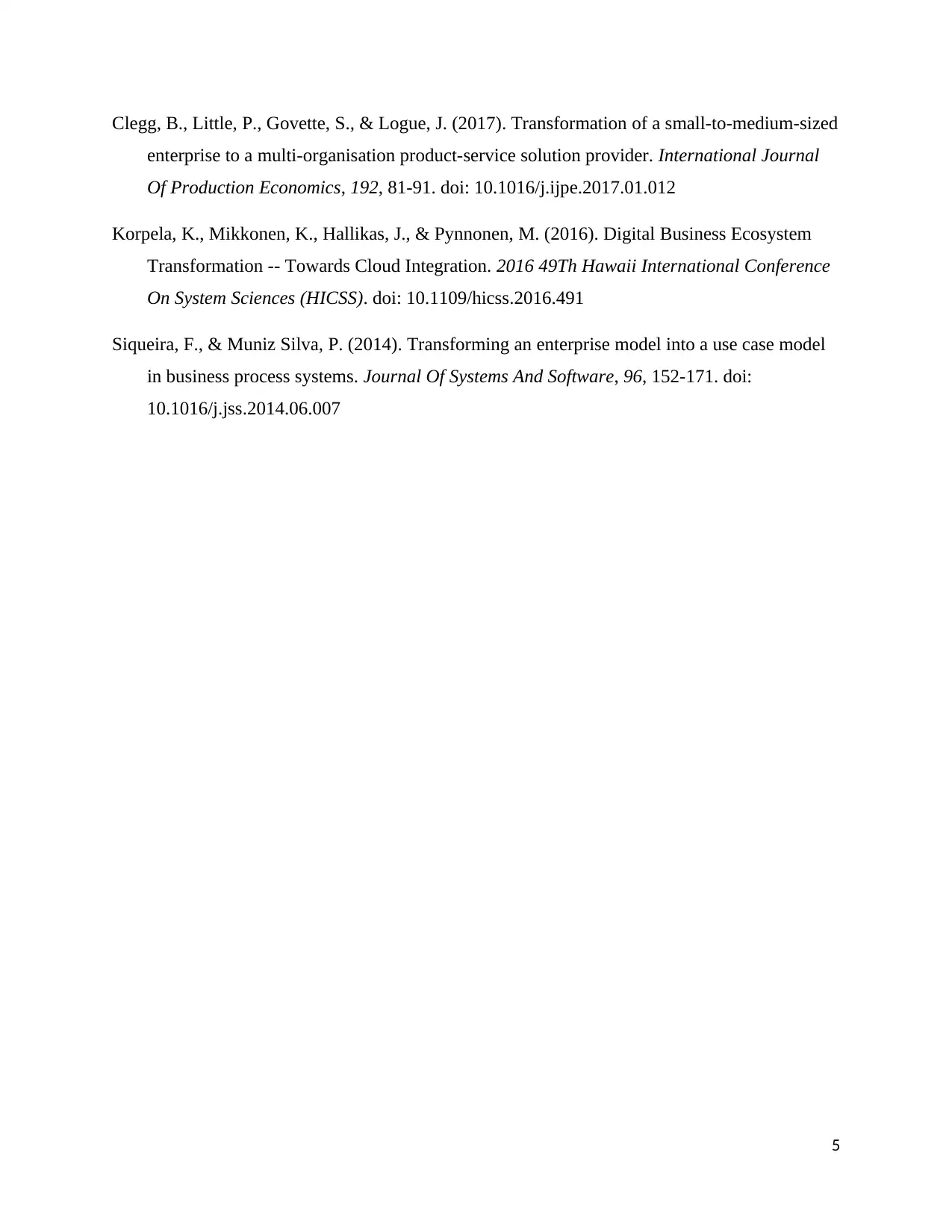
Clegg, B., Little, P., Govette, S., & Logue, J. (2017). Transformation of a small-to-medium-sized
enterprise to a multi-organisation product-service solution provider. International Journal
Of Production Economics, 192, 81-91. doi: 10.1016/j.ijpe.2017.01.012
Korpela, K., Mikkonen, K., Hallikas, J., & Pynnonen, M. (2016). Digital Business Ecosystem
Transformation -- Towards Cloud Integration. 2016 49Th Hawaii International Conference
On System Sciences (HICSS). doi: 10.1109/hicss.2016.491
Siqueira, F., & Muniz Silva, P. (2014). Transforming an enterprise model into a use case model
in business process systems. Journal Of Systems And Software, 96, 152-171. doi:
10.1016/j.jss.2014.06.007
5
enterprise to a multi-organisation product-service solution provider. International Journal
Of Production Economics, 192, 81-91. doi: 10.1016/j.ijpe.2017.01.012
Korpela, K., Mikkonen, K., Hallikas, J., & Pynnonen, M. (2016). Digital Business Ecosystem
Transformation -- Towards Cloud Integration. 2016 49Th Hawaii International Conference
On System Sciences (HICSS). doi: 10.1109/hicss.2016.491
Siqueira, F., & Muniz Silva, P. (2014). Transforming an enterprise model into a use case model
in business process systems. Journal Of Systems And Software, 96, 152-171. doi:
10.1016/j.jss.2014.06.007
5
1 out of 6
Related Documents
Your All-in-One AI-Powered Toolkit for Academic Success.
+13062052269
info@desklib.com
Available 24*7 on WhatsApp / Email
![[object Object]](/_next/static/media/star-bottom.7253800d.svg)
Unlock your academic potential
© 2024 | Zucol Services PVT LTD | All rights reserved.





